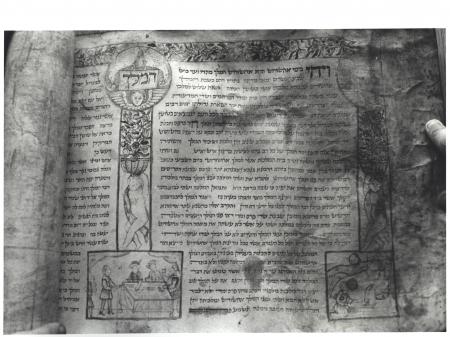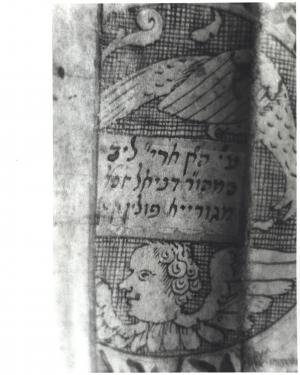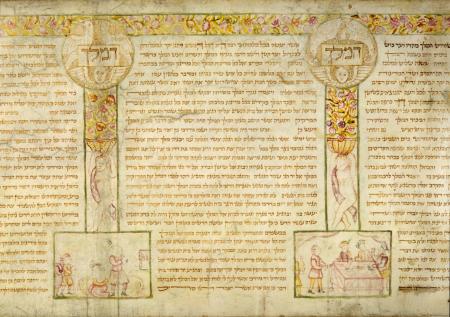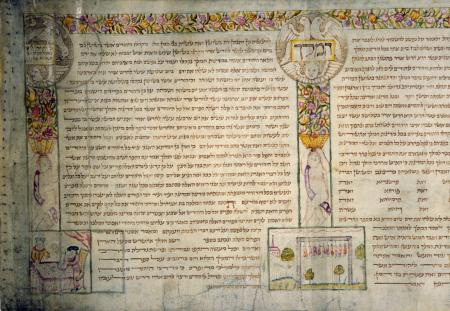Obj. ID: 23765
Hebrew Illuminated Manuscripts JHM Aryeh Leib ben Daniel of Goray Early Esther Scroll, Central Europe, 1736/1737
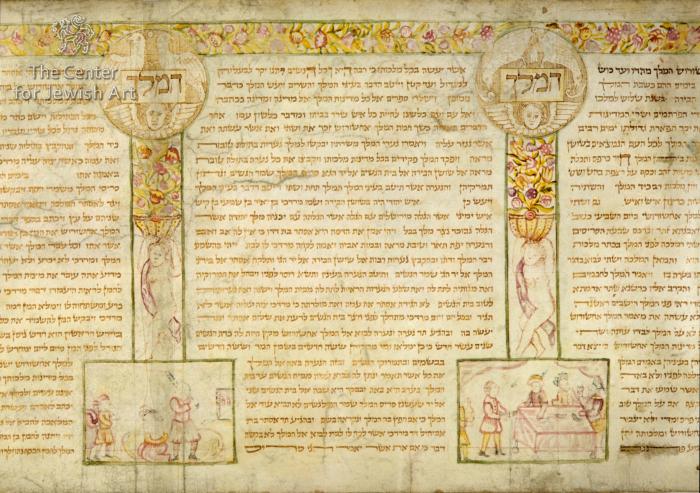
The scroll features the style of the early scrolls (from the 1730s) produced by Aryeh Leib ben Daniel of Goray (Pol. Goraj), Poland. The upper margins are decorated with floral motif. The Hebrew text of the Book of Esther is written in rectangular text panels and the spaces between them are filled with almost naked supporters holding baskets with flowers. Above them are roundels containing the enlarged word ha-melekh ("the king") decorated with two birds (they are depicted in different configurations) and an angel's head; in the last of them, the scribe penned his colophon. Below the supporters, there are rectangular frames containing narrative scenes from the Esther story.
The text panels are big and wide.
The lines of the decorations that currently are light green, could originally be gold.
The scroll is stored unrolled within a frame.
sub-set tree:
A | Angel of Death | Angel's head
B | Bird
H | Heraldic composition | Supporters
B | Basket | Basket with flowers
O | Ornamentation: | Foliate and floral ornaments
W | Word, framed
O | Ornamentation: | Main text framed
|
The initial and final sections of the scroll are very dark and dirty.
There are some stains on the membranes.
A part of the scribal inscription written at the beginning is barely visible.
The inscription on the right margin of the first membrane is illegible.
The Book of Esther in Hebrew
The scroll is formed of 3 sheets, containing in total 9 columns of the text of 27 lines of various lengths.
Every membrane includes 3 columns of text.
The text is written in Hebrew square Ashkenazi script with tagim, in brown ink on the flesh side of the parchment membranes that seem to be of medium thickness and rather suede.
The letters ח (Es. 1:6) and ת (Es. 9:29) are enlarged. Enlarged and diminished letters are included in the Haman's sons section.
The initial word of the scroll is enlarged and bolded.
The text includes numerous elongated letters and some erasures and corrections are visible in it.
The names of God are highlighted by enlarged and bolded letters, e.g. col. 2.
The ruling is well visible - horizontal and vertical lines - along with the membranes.
The pricking can be seen at the beginning and end of the scroll.
The membranes in the scroll are glued together.
Colophon of the artist-scribe is divided into two parts that are penned in the semicircles placed at the beginning and at the end of the manuscript. The text in the first semicircle bears the date but is faded and only barely visible. In the second semicircle, the artist-scribe included his name - Aryeh Leib ben Daniel of Goray Polin Katan.
The scroll is available on the Museum's website: https://data.jck.nl/page/aggregation/jhm-museum/M000416 (accessed on 24.05.2021).
Bibliography on other scrolls made by Aryeh Leib ben Daniel of Goray or attributed to him:
Dagmara Budzioch, The Decorated Esther Scrolls from the Museum of the Jewish Historical Institute in Warsaw and the Tradition of Megillot Esther Decoration in the Seventeenth and Eighteenth Centuries – An Outline [Polish: Dekorowane zwoje Estery z Żydowskiego Instytutu Historycznego w Warszawie na tle tradycji dekorowania megilot Ester w XVII i XVIII wieku. Zarys problematyki], Warsaw 2019, 1:206-215.
Ernest Namenyi, "The Illumination of Hebrew Manuscripts after the Invention of Printing," in Cecil Roth (ed.), Jewish Art, an Illustrated History (London, 1961), col. 435.
Mendel Metzger, The Earliest Engraved Italian Megilloth, Bulletin of the John Rylands Library 1966, 48/2, esp. 409, 422-425.
Olga Sixtova, O svitku / Form of the Scroll [katalog k výstavě konané v Galerii Roberta Guttmanna Židovského muzea v Praze od 22. června do 26. července 2006], Prag 2006, 32-33.
A Journey through Jewish Worlds: Highlights from the Braginsky Collection of Hebrew Manuscripts and Printed Books, eds. Evelyn M. Cohen, Emile Schrijver, Sharon Liberman Mintz, Amsterdam 2009, 246-249.
Schöne Seiten. Jüdische Schriftkultur aus der Braginsky Collection, eds. Emile Schrijver, Falk Wiesemann, Evelyn M. Cohen, Sharon Liberman Mintz, Menahem Schmeltzer, Zurich 2011, 266-269.
A Fine Illustrated Esther Scroll, [ca. 1740], lot 105, Sotheby's New York Important Judaica, 20 December 2017 https://www.sothebys.com/en/auctions/ecatalogue/lot.105.html/2017/important-judaica-n09687 (accessed on 31.07.2020).
A Magnificent Esther Scroll Written and illustrated Aryeh Leib ben Daniel of Goray, Schwelm, 1737, lot 187, Sotheby's New York Important Judaica Including Property from the Estate of Shlomo Moussaieff, 15 December 2016 https://www.sothebys.com/en/auctions/ecatalogue/2016/important-judaica-n09589/lot.187.html (accessed on 31.07.2020).


